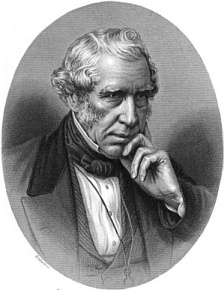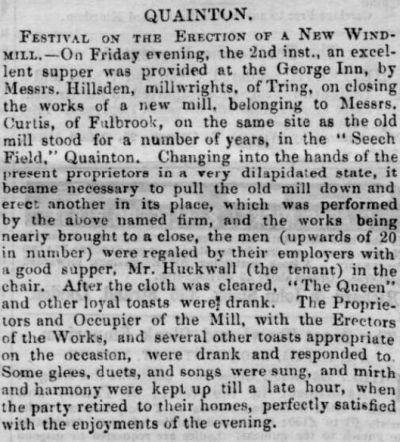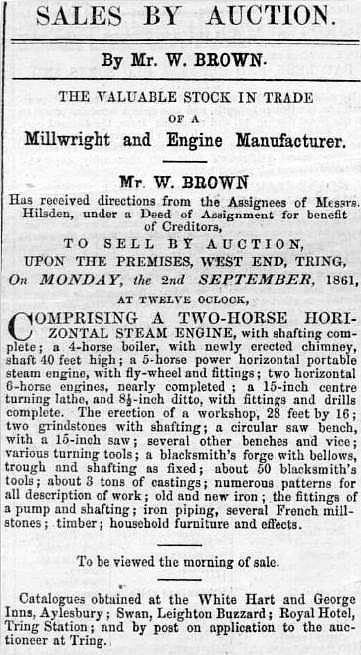|
|
 |
|
Fig. 5.2: Sir
William Fairburn,
civil engineer |
The 19th
century civil engineer, Sir William Fairbairn (1789-1874) [5] began
his working life as an apprentice millwright at Newcastle-upon-Tyne. In his Treatise on Mills and Millwork (1865), Fairbairn provides an
interesting insight into the millwright’s work during the 18th
century:
|
“. . . . the millwright of the last century was an itinerant
engineer and mechanic of high reputation. He could handle the axe,
the hammer, and the plane with equal skill and precision; he could
turn, bore and forge with the ease and despatch of one brought up to
these trades, and he could set out and cut in the furrows of a
millstone with an accuracy equal or superior to that of the miller
himself. These duties he was called upon to exercise, and seldom in
vain, as in the practice of his profession had he mainly to depend
upon his own resources.” |
Thus, the millwright’s trade combined elements of those of the
carpenter, blacksmith and stone mason, while he needed to be of a
practical and resourceful turn of mind. His occupation also demanded
the ability to design mills and milling machinery, which required
the application of arithmetic and geometry to the manufacture of all
the components of a working mill. Fairbairn tells us that . . . .
“. . . . he could calculate the velocities, strength, and power of
machines, could draw in plan, and section, and could construct
buildings, conduits, or watercourses, in all the forms and under all
the conditions required in his professional practice. . . ."
During the windmill era, the millwright performed much of the work
of today’s civil engineer and it is not difficult to see why some of
the more gifted among their ranks became our first great civil
engineers. Expertise also flowed in the opposite direction. John
Smeaton, famous for the Eddystone Lighthouse (and the first to
proclaim himself a “civil engineer”), while not a millwright by trade,
performed valuable research into the design of milling equipment. He
investigated sail design and was the first to employ cast iron in
place of wooden parts in the construction of milling machinery.
Fairbairn also tells us something about the millwright’s standing in
society . . . .
“. . . . living in a more primitive state of society than ourselves,
there probably never existed a more useful and independent class of
men than the country millwrights. The whole mechanical knowledge of
the country was centred amongst them, and, where sobriety was
maintained and self-improvement aimed at, they were generally looked
upon as men of superior attainments and of considerable intellectual
power.”
Perhaps Fairbairn’s opinion was rose-tinted, for the two local
millwrights for whom we have been able to obtain information, while
offering the range of skills that he describes, do not appear to
have matched them with a high degree of business acumen.
THE DECLINE OF THE MILLWRIGHT’S TRADE
As the Industrial Revolution progressed, millwrights were pressed
into service to build the first powered textile mills. James Watt’s
condensing steam engine developed into an economical and reliable
driving force and, unlike wind and water power, one that offered a
stable source of motive power. Gradually, wind and water mills were
replaced, first by steam-driven machinery and eventually by electric
power, while small local grain mills gave way to large factory units
catering for entire regions of the country. As for the millwright,
his work was mostly lost in the evolution of other trades, such as turners,
fitters, machine makers and mechanical engineers.
LOCAL MILLWRIGHTS
THE HILLSDONS OF TRING

Fig. 5.3: Bucks Herald,
10th November 1855
Waddesdon-born John Hillsdon came to Tring in about 1825. The 1841
Census records him living at Tring Wharf with his wife and five
children, where he worked as a miller at Gamnel Wharf mill (Chapter
VII) together with his 16-year old son, John.
By 1850 John had left Gamnel to trade on his own account, describing
himself as a ‘Millwright’ and occupying premises on the corner of
Chapel Street and King Street in Tring. Ten years later the Hillsdon’s venture into the world of business had proved unwise, for
their financial affairs were in a parlous condition. On 15th
December 1860 an announcement appeared on the front page of The
Bucks Advertiser & Aylesbury News:
|
 |
|
Fig. 5.4: Bucks
Herald, 24th August 1861.
Bankruptcy sale of Hillsdon’s assets |
|
“Notice is hereby given that by indenture dated the 7th day of
December 1860, John Hillsdon the elder and John Hillsdon the younger
of Tring, in the County of Hertford, Engineers, assigned all their
personal estate and effects whatsoever and wheresoever to William
Smith Simkin of No 6 Leadenhall Street, London, Ironmonger, and John
Nevins of Nos 1 & 2 Great Guildford Street, London, Ironmonger, upon
Trust for the benefit of themselves, and all the creditors of the
said John Hillsdon the elder and John Hillsdon the younger . . . .
In the presence of John Merritt Shugar of Tring, Solicitor.” |
In spite of this drastic measure, in the following year Johns senior
and junior — now described as agricultural machine makers — are
found in the records of the Hertford Union Gaol & House of
Correction, imprisoned for debt. By no means an uncommon offence at
that time, the Hillsdon’s fellow inmates were other assorted
traders, including a china dealer, a market gardener and a straw hat
maker.
In May, 1861, John Jnr. petitioned for his discharge, his debts
amounting to £587. 14s, offering to pay 10s in the pound. All
his creditors concurred, save one, a solicitor, to whom Hilsdon owed
£21, but the objection was set aside and John was discharged.
What happened to his father is unrecorded, but they
weathered the storm and returned to carry on business in the same
premises as before. In 1869 John junior placed an ambitious
advertisement for Tring Iron Works in Kelly’s Trade Directory, where
he is described as “engineer; millwright; manufacturer of portable
and fixed steam engines, water wheels; corn, bone, bark and colour
miller; and iron and brass founder”. No more is heard of John junior
in Tring, but it is believed that he and his wife emigrated to New
Zealand, leaving there seven years later for the USA. George
Hilsdon, a younger son, also followed the family tradition and
remained with his father at the King Street business.
The firm of Hillsdon was undoubtedly involved in a wide range of
mill-related business, but all that is now known is that they erected the tower mill at
Hawridge Common (Chapter IX), installed the steam engine at
Wendover windmill (Chapter X)
and were possibly involved in the construction of Goldfields and
Waddesdon mills. [6] John senior is last recorded in 1871, a widower of 76
living in lodgings in Frogmore Street, Tring. It is believed that
the Hillsdon’s firm, Tring Ironworks, closed around 1905.
WILLIAM COOPER OF AYLESBURY
Almost all that is known of William Cooper and his business are
contained in two account books now held in the Buckinghamshire
Archives.
On October 11th, 1831, an announcement in the London Gazette stated
that the partnership between William and Joseph Cooper, Millwrights
and Smiths of Aylesbury, Bucks, had been dissolved by mutual
consent. The following year William Cooper was declared bankrupt,
his two account books passing into the custody of the court. One is
a general ledger in which are recorded his business transactions
between May 1827 and September 1832, the other records expenses
incurred between April 1830 and January 1831 in connection with
fitting out Champness windmill at Fulmer.
In common with the Hillsdons, the ledger shows that Cooper performed
a surprising range of work. This extended from simple repairs
to stoves and locks, to more complex work on agricultural machinery,
through to the installation of all the equipment at Fulmer and
Quainton windmills. The ledger also shows that Cooper
worked on some thirty wind and water mills in and around Aylesbury,
including a windmill at Tring (but unclear which) and those at Waddesdon (Chapter
XIV), Wingrave (Chapter XIV),
and Wendover. He also undertook work on the treadmill in
Aylesbury Gaol and on an unspecified type of mill at Winslow
Workhouse.
The cost of fitting out Champness mill was £445 8s.10d., of which
almost half was for labour, the balance being for canvas (121
yards), tacks (22,000), screws (13 gross), nails, chisels, ironwork,
timber, and “Different things”. Wages paid to the skilled men were
four shillings a day, while the daily rate for the two labourers was
two shillings.
Among Cooper’s smaller jobs are recorded the repair of butter
churns; roughing of horse shoes; mending wagons; repairing a kitchen
range; mending a rat trap; ringing pigs; mending plough shears; and
to a Mr. Collins he supplied “12 stoves different sizes”. If nothing
else it seems that the millwright of the age was versatile.
What led to Cooper’s bankruptcy is unknown, although in the Fulmer
book there are references to expenses of a legal nature: “Copy of a Rit” (writ), expenses for “Sherrfs officer”, and “Lawyer Charge”,
which suggest that he might have been owed money for work on the
mill. There are also several entries that refer to the purchase of pints
and quarts of gin and rum.
Apart from these account books, the Aylesbury Poor Rate Book for
1831-2 records that Cooper’s premises were in Walton Street on a
site now occupied by the White Swan, but by 1835 the foundry had
gone. |